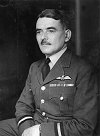
[click to enlarge]
|
HERITAGE - FAMOUS PEOPLE
Sir Frank WhittleJet Engine Pioneer
|
|
| MAJOR ACHIEVEMENT |
Inventor of the jet engine |
| BORN |
1 June 1907, Newcombe Road, Coventry |
| DIED |
8 August 1996, Columbia, Maryland, USA |
| CAUSE OF DEATH |
Cancer |
| FAMILY |
Eldest son of a factory foreman
Married in 1930, divorced in 1976. Married second wife, Hazel, in the USA in the same
year.
Two children, David and Ian. |
| EDUCATION |
Earlsdon Council School
Leamington College
Royal Air Force College, Cranwell
Cambridge University |
| |
| CAREER |
|
| 1923 |
RAF Cranwell, aircraft apprentice |
| 1926 |
Selected for officer and pilot training |
| 1928 |
Writes his final thesis for the RAF College -
contains the initial germ of the idea for jet propulsion. Becomes a commissioned officer |
| 1929 |
Develops the initial idea of the jet engine -
using a gas turbine to produce a propelling jet. |
| 1930 |
Applies for a patent for the jet engine
concept - "a reaction motor suitable for aircraft propulsion" (granted
April 1931).
The idea is ignored by the Air Ministry. |
| 1931-32 |
Test pilot on floatplanes and flying boats |
| 1934 |
Flight Lieutenant Frank Whittle sent to
Cambridge University as a mature student by the RAF. Enters Peterhouse College. Whilst at
Cambridge encouraged to pursue his idea for jet propulsion. |
| 1935 |
While at Cambridge University meets up with
two former RAF pilots keen to develop the jet engine. |
| 1936 |
Power Jets Ltd set up by Whittle and
colleagues in a factory in Rugby owned by BTH.
[In Germany, Herbert Wagner and Hans von Ohain independently and in
secret begin development of their own turbojet proposals at Junkers
and Heinkel respectively.] |
| 1937 |
Power Jets tests first experimental bench
engine, the WU. |
| 1938 |
Testing moves to a derelict foundry in
Lutterworth for safety reasons. |
| 1939 |
The Air Ministry's Director of Scientific
Research finally acknowledges that Whittle's ideas are feasible. Power Jets are awarded a
contract to develop a flight engine, the W1.
[The contract to build a plane to put the engine in is given to the Gloster Aircraft
Company] |
| 1941 |
15 May : first test flight of a Gloster E28/39
powered by Whittle's jet engine.
October : an engine prototype (W1X) is shipped to General
Electric in the USA.[A jet-engined
Heinkel He 178, developed from von Ohain's work, had first flown in Germany on 27 August
1939 - but the flight had not been very successful and it took the Germans another five
years to perfect the technology]
[America's first jet plane built in 1943] |
| 1944 |
First official public news of the jet engine.
A jet-engined Gloster Meteor flies in combat - the only Allied jet aircraft to participate
in World War Two. The Power Jets company is nationalised. |
| 1946 |
Taken off the design and development of jet
engines. Resigns from the project.
Awarded the Daniel Guggenheim Medal for the development of the jet engine. |
| 1948 |
Invalided out of the Air Force with health
problems caused by stress.
Knighted by King George VI.
Becomes Honorary Technical Adviser to BOAC. |
| 1952 |
Writes autobiography 'Jet - The Story of a
Pioneer'. |
| 1953 |
Joins Shell as a technical adviser, mainly
involved with oil well drilling technology. |
| 1959 |
Consultant and lecturer. |
| 1961 |
Becomes technical consultant to Bristol
Siddely Engines. |
| 1966 |
Awarded the Coventry Award of Merit. |
| 1976 |
Emigrates to the USA. |
| 1977 |
Research Professor at the US Naval Academy,
Annapolis. |
| 1986 |
Receives the Order of Merit from the Queen. |
| 1991 |
Awarded the Charles Stark Draper Prize jointly
with Hans von Ohain. |
| 1992 |
Awarded the SAE Aerospace Engineering
Leadership Award jointly with Hans von Ohain. |